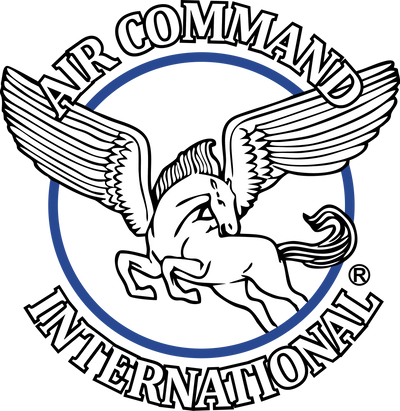Test Data
The following details pertain to the design, development, materials, engineering, and testing of the Skywheels rotor systems.
Static Stress Tests Performed on our Rotor System Components
Using a static test fixture, hydraulic rams are used to simulate blade tension and aircraft weight. The attachment fixtures allow both ends of the test section to cone freely, and one end is free to rotate in the pitch mode.
The section being tested is a standard long center section, which is used on all of our rotor systems over 25 feet in diameter. The blade roots being tested are similar to the roots of the blade used in a 29-foot diameter rotor set. The test had three purposes. One was to determine the load required to cause a center section failure, and the manner in which the failure occurs. The second purpose of this test was to determine the ultimate tensile strength of the blade to center section attachment point. The third purpose was to determine magnitude of the bending stress on the blade root that is a result of the out-of-plane bending stiffness of the center section.
The test section had a load applied that would correspond to 8,000 pounds of lift and 36,000 pounds of blade tension. This amount of tension results from a rotor RPM of approximately 700 for a 29-foot diameter rotor, which is most likely unattainable in-flight. No damage to any component was detectable at this load, and no significant out-of-plane bending was detectable at the blade root.
At a load that would correspond to 40,000 pounds of blade tension (730RPM) and 12,000 pounds of lift, cracks started to appear on the bottom of the center section at the teeter block attachment holes. At 44,000 pounds of blade tension, cracks started to appear at the center section's outermost blade retention hole. At 52,000 pounds of blade tension, the blade attachment bolts and holes were severely deformed but did not fail catastrophically.
It should be noted that the above loads are by all calculable means impossible to attain while in-flight. Compressibility drag at the rotor tips would limit the RPM to a value much lower than that represented in the above tests. Likewise, the lifting loads in the above tests are also highly improbable because without the high RPM a large portion of the rotor would be in a stalled condition. A 29-foot diameter rotor system at 300 RPM has a blade tension at the root of approximately 7,000 pounds, and will lift up to 1,000 pounds at that RPM with the proper blade pitch. The severity of the above tests are meant to give an indication of the excess margin of safety designed and built into our blade systems.
In-Flight Shear Stress Placed on the Trailing Edge Bond
The following test was performed to determine the in-flight shear stresses imposed upon the trailing edge bond of the rotors.
The chord-wise lift distribution caused by the aerodynamic loads upon the rotor blade results in normal and shear stresses upon the bond between the top and bottom composite skins and the aluminum spar, that when measured in pounds/sq. inch are never over two digits in magnitude. In-house experimentation has resulted in test bonds with ultimate normal stresses of 3500-5000 pounds/sq. inch, and ultimate shear stresses of 2300-4600 pounds/sq. inch. After applying a safety factor of 1.5 (FAR Part 27.303) this results in a minimum positive limit maneuvering load factor of at least 23 (3.5 is all that is required by FAR Part 27.337).
A test was devised to prove the validity of the above load calculations regarding the shear and normal stresses on the trailing edge bond. For the purpose of the test a 23 foot diameter blade was constructed, that was standard in every way, except that the trailing edge was left un-bonded in two areas. One un-bonded area, 12 inches in length, was centered 3 feet from the tip. The other un-bonded area, also 12 inches in length, was centered 3 feet from the root.
The un-bonded area was bolted together with #4 counter-sunk bolts every inch, and corresponding bolts were installed in the same location on the un-modified blade to maintain the proper balance.
The blades were then balanced and tracked.
The rotor set was then mounted on our test vehicle, which is a car with rotor head mounted on the roof, for the purpose of simulating in-flight loads and stresses.
The first run was made with all the trailing edge bolts in place to simulate an un-modified system, and to get a feel of the amount of stick shake present in this particular rotor set.
The bolts were then removed from both blades one at a time, starting at the outermost bolt and moving inward, in order to see at what point the un-bonded area would start to propagate into the bonded area.
For the purpose of clarification, a test run is approximately two miles long, with the blade RPM being varied from 300 to 500 RPM. During the duration of the test run, the control stick to the rotor head is cycled in its pitch mode from full forward to full aft (25 degrees of travel), at approximately one cycle per second. During these cycles, the lift generated by the rotor set will cycle from 500 to 1200 pounds. Note that these loads are difficult, if not impossible, to obtain during actual flight for reasons relating to aircraft stability. During the test runs care was taken to notice any change in stick shake that would indicate blade deformation, and any change in track that would indicate a loss of lift of one blade caused by the change in airfoil shape due to trailing edge separation.
At the end of each test run the length of the un-bonded area was measured to determine if further delaminating was occurring.
All the bolts were removed, one at a time, from the out-board and the in-board test areas, with one test run made for each bolt removal. The stick shake did not change, the blades remained in track, and the length of the un-bonded areas did not increase.
At this point, with the aid of a large knife, we increased the length of the out-board un-bonded area to 25 inches, and the in-board un-bonded area to 20 inches, with a test run after each modification.
With a total of 45 inches of the trailing edge un-bonded, which is 37.5% of the exposed blade, there was no change in stick shake, no propagation of the un-bonded area, and no change in blade track. This indicates no change in shape (airfoil) or resultant loss of lift between the modified and un-modified blade.
This test proves that the loads imposed upon the bonds within the rotor blade structure are small compared to the ultimate strength of those bonds, which agrees with calculation.



